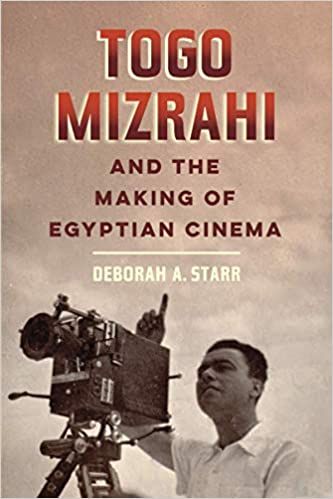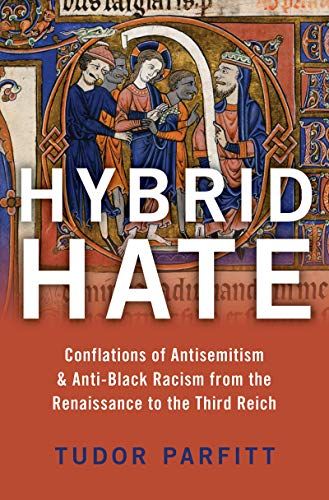
Deborah Starr’s new book is an impressive exploration—indeed, a reclamation—of a remarkable, yet forgotten and downplayed, career in film-making. Part biography, part film history, and part film analysis, it follows the career of Joseph Elie (Togo) Mizrahi (1901-1986) as a film director and producer in 1930s and 1940s Egypt, and offers an in-depth study of his cinematic idiom. By recovering Mizrahi’s—a Jewish Egyptian (with Italian nationality papers)—place in Egyptian film history, this book makes a substantial contribution to several fields of study: to Jewish Studies, Middle East Studies, and Cultural Studies, and more specifically, to Egyptian and Jewish Egyptian cultural history. Indeed, the book highlights the synergies between those fields, thus adding to the growing scholarship in recent years that rethinks Jews from the Middle East and North Africa as part of the societies in which they lived. (Although Starr still uses the descriptor “Egyptian Jew,” her book, in fact, makes a strong case for using “Jewish Egyptian” instead, as this review will do.)
Following an introductory chapter, in which Starr lays the requisite historical context and discusses what constitutes a national cinema, she sketches Mizrahi’s professional biography as a filmmaker in Egypt, and sieves through the conflicting reports about the seemingly abrupt end of his career and his move to Italy in 1946. In the following chapters, Starr analyzes the contents of Mizrahi’s major films, usually a pair in each chapter, combining a thematic and chronological approach that both represents the different phases in his film-making, and examines his original cinematic idiom. Thus, she tackles such issues as identity and belonging to the Egyptian nation, gender and queerness, race and ethnicity, social class, and notions of bourgeois morality. In the final chapter, Starr explores the enduring popularity of Mizrahi’s films to this day, and celebrates their cultural legacy.
In this framework, Starr’s main concern is with Jewish belonging to the Egyptian nation, before that community was dispersed in the late 1950s and 1960s. Both in the introduction and the conclusion, she convincingly argues against post-colonial, nationalist, critiques that dismissed Mizrahi’s films as devoid of real national and social value, as derivative of Hollywood and Western culture more generally, and as entertainment of little import. By contrast, Starr emphasizes Mizrahi’s foundational contribution to the Egyptian film industry, not only as a cineaste, but also as a studio owner, a producer, and a leader in professional organizations, and she also highlights his public championing of that industry as a national one. But she mainly theorizes what she calls a “Levantine cinematic idiom” as a tool to analyze Mizrahi’s films and their message: it highlights their representation of ethno-religious coexistence, their pluralistic aesthetics, and their focus on the performativity of identity (pp. 53-55). For Starr, this Levantine idiom, prevalent in the farcical films Mizrahi made in Alexandria during the 1930s, challenged nationalist ideologies that excluded non-Muslims, non-Arabs, and foreign nationals from the Egyptian nation; while the musical melodramas that he made in Cairo during the 1940s indicated Jewish anxieties about such growing exclusionary ideologies and policies, as well as about the potential of Zionism to adversely impact Jewish belonging in Egypt. The choice of the term “Levantine”—which Starr uses to replace “Cosmopolitan”—might be objected to on several grounds: it refers to a geographical area that is not Egypt; it was rarely used by Jewish (or other) Egyptians in that sense, at that time; and it carries its own heavy burden of significations. However, these objections are muted by Starr’s very exact definition of what she means by Levantine, and by her consistent application of that definition throughout the book.
Starr expertly dissects the focus of that Levantine genre on identity, with its farces of mistaken identities, masquerades, and carnivalesque narratives (duly referencing Bakhtin). But she then goes a step further and uses queer theory to explore the homosexual innuendos and representations in Mizrahi’s 1930s comedies, as well as his use of cross-dressing. She argues that such instances not only highlighted Jewish-Muslim coexistence, but also poked fun at bourgeois notions of proper masculinity and modernity that emerged during that period in Egypt. Moreover, she reads Mizrahi’s 1940s musical films as reinforcing new ideas that prescribed love marriages and monogamy as prerequisites for modernity, and proscribed old practices of prostitution and slavery—and the sexual availability of women that they entailed—as fundamentally at odds with modernity.
There are several more aspects to Mizrahi’s prolific work which Starr broaches in her comprehensive study, but still beg further exploration. A quick survey of the other cinematic genres used in Egyptian films at the time would have enhanced our understanding of the context in which, or against which, Mizrahi’s Levantine idiom was operating. In particular, a fuller consideration of the Egyptian comedic theater would better contextualize Mizrahi’s oeuvre, since so much of that theatrical tradition carried over to Egyptian film, especially in its first decades, including themes, narratives, genres, stock characters, comic devices, and visual language, to the extent that some of Mizrahi’s early films looked like recorded theater plays. Starr addresses this only in chapter 5, when discussing the long and successful collaboration between Mizrahi and Ali al-Kassar, a veteran star of the Egyptian comedic theater. Al-Kassar had substantial creative control over his plays and films (as did star singer Umm Kulthum, whose collaboration with Mizrahi Starr examines in chapter 7). This opens up a question about Mizrahi’s creative input and how much he owed to his collaborators, but more importantly, it opens up a discussion of what he owed to the comedic theater more generally. It can be argued that Mizrahi only added a stock character of a Jewish Egyptian (Chalom) to the repertoire of various Egyptian characters created by the theatrical tradition. If so, it tones down, to an extent, the challenge that Chalom supposedly posed to Egyptian exclusionary nationalism, and instead, it emphasizes the importance of social class in understanding Mizrahi’s carnivalesque farces. Starr interprets Mizrahi’s use of the lower-class, local, stock character called ibn al-balad in Arabic, as an attempt to impart some kind of national authenticity to Chalom: that might be so, but it should be noted that the full association of ibn al-balad with Egyptian nationalism peaked only later, in the Nasserist period. In the interwar period, this understanding of ibn al-balad was still developing, while its middle-class counterpoint, the effendi, whom Starr discusses in later chapters of her book, was still considered the epitome of Egyptian nationalism.
As always, the question of reception looms large in such film histories. Apart from the later exclusion of Mizrahi’s films from Egyptian nationalist historiography, did contemporary critics and audiences understand them the way that Starr does, as offering a vision of a more inclusive Egyptian nationalism? She only discusses how the contemporary cultural press hailed Mizrahi’s professional skills and the high production quality of his films, while occasionally criticizing the bawdiness of his early comedies. We are left to wonder about the real-time impact of their Levantine—subtle—messaging, during a period when exclusionary Egyptian nationalism gained more ground. Starr’s captivating discussion of the enduring popularity of Mizrahi’s films, even in the era of YouTube, in the coda of her book, is a significant addition to her other scholarly work, in which she explored the growing nostalgia in Egypt for the interwar period as an alternative vision of a pluralist society.
Finally, the extremely clear language of Starr’s text, devoid of jargon even when introducing theory, is a matter of great distinction, as it makes this book accessible to a wider audience than just the expert one. Readers of all stripes would find Togo Mizrahi and the Making of Egyptian Cinema to be an outstanding research about the contribution of Jewish Egyptians to Egyptian modern culture, and an innovative exploration of its making.
